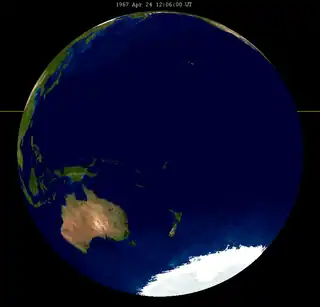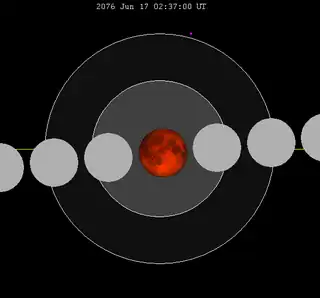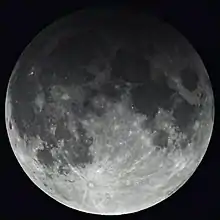January 2000 lunar eclipse
A total lunar eclipse took place on Friday 21 January 2000, the first of two total lunar eclipses in 2000.
| Total Lunar Eclipse 21 January 2000 |
||
|---|---|---|
.jpg.webp) Partial from Buenos Aires, 3:20 UTC | ||
 The moon passes west to east (right to left) across the Earth's shadow, shown in hourly intervals. | ||
| Series (and member) | 124 (48 of 74) | |
| Gamma | -0.2957 | |
| Magnitude | 1.3246 | |
| Duration (hr:mn:sc) | ||
| Totality | 1:16:59 | |
| Partial | 3:23:19 | |
| Penumbral | 5:18:12 | |
| Contacts (UTC) | ||
| P1 | 2:04:26 | |
| U1 | 3:01:50 | |
| U2 | 4:05:01 | |
| Greatest | 4:43:31 | |
| U3 | 5:22:00 | |
| U4 | 6:25:09 | |
| P4 | 7:22:38 | |
 The Moon passed straight through the center of the Earth's shadow at the descending node in Saggitarius. | ||
Visibility

Related lunar eclipses
Eclipses of 2000
- A total lunar eclipse on January 21.
- A partial solar eclipse on February 5.
- A partial solar eclipse on July 1.
- A total lunar eclipse on July 16.
- A partial solar eclipse on July 31.
- A partial solar eclipse on December 25.
Lunar year series
| Lunar eclipse series sets from 1998–2002 | ||||||||
|---|---|---|---|---|---|---|---|---|
| Descending node | Ascending node | |||||||
| Saros | Date Viewing |
Type Chart |
Gamma | Saros | Date Viewing |
Type Chart |
Gamma | |
| 109 | 1998 Aug 08 |
penumbral |
1.4876 | 114 | 1999 Jan 31 |
penumbral |
−1.0190 | |
| 119 | 1999 Jul 28 |
partial |
0.7863 | 124.jpg.webp) |
2000 Jan 21 |
total |
−0.2957 | |
| 129 | 2000 Jul 16 |
total |
0.0302 | 134_(cropped).jpg.webp) |
2001 Jan 09 |
total |
0.3720 | |
| 139 | 2001 Jul 05 |
partial |
−0.7287 | 144 | 2001 Dec 30 |
penumbral |
1.0732 | |
| 149 | 2002 Jun 24 |
penumbral |
−1.4440 | |||||
| Last set | 1998 Sep 06 | Last set | 1998 Mar 13 | |||||
| Next set | 2002 May 26 | Next set | 2002 Nov 20 | |||||
Tritos series
The tritos series repeats 31 days short of 11 years at alternating nodes. Sequential events have incremental Saros cycle indices.
This series produces 20 total eclipses between April 24, 1967 and August 11, 2185, only being partial on November 19, 2021.
| Tritos eclipse series (subset 1901–2087) | ||||||
|---|---|---|---|---|---|---|
| Descending node | Ascending node | |||||
| Saros | Date Viewing |
Type chart |
Saros | Date Viewing |
Type chart | |
| 115 | 1901 Oct 27 |
Partial |
116 | 1912 Sep 26 |
Partial | |
| 117 | 1923 Aug 26 |
Partial |
118 | 1934 Jul 26 |
Partial | |
| 119 | 1945 Jun 25 |
Partial |
120 | 1956 May 24 |
Partial | |
| 121 | 1967 Apr 24 |
Total |
122 | 1978 Mar 24 |
Total | |
| 123 | 1989 Feb 20 |
Total |
124 | 2000 Jan 21 |
Total | |
| 125 | 2010 Dec 21 |
Total |
126 | 2021 Nov 19 |
Partial | |
| 127 | 2032 Oct 18 |
Total |
128 | 2043 Sep 19 |
Total | |
| 129 | 2054 Aug 18 |
Total |
130 | 2065 Jul 17 |
Total | |
| 131 | 2076 Jun 17 |
Total |
132 | 2087 May 17 |
Total | |
| 133 | 2098 Apr 15 |
Total | ||||
Half-Saros cycle
A lunar eclipse will be preceded and followed by solar eclipses by 9 years and 5.5 days (a half saros).[1] This lunar eclipse is related to two annular solar eclipses of Solar Saros 131.
| January 15, 1991 | January 26, 2009 |
|---|---|
 |
 |
References
- Mathematical Astronomy Morsels, Jean Meeus, p.110, Chapter 18, The half-saros
External links
- Saros cycle 124
- 2000 Jan 21 chart Eclipse Predictions by Fred Espenak, NASA/GSFC
Wikimedia Commons has media related to Lunar eclipse of 2000 January 21.
This article is issued from Wikipedia. The text is licensed under Creative Commons - Attribution - Sharealike. Additional terms may apply for the media files.

_(cropped).jpg.webp)
